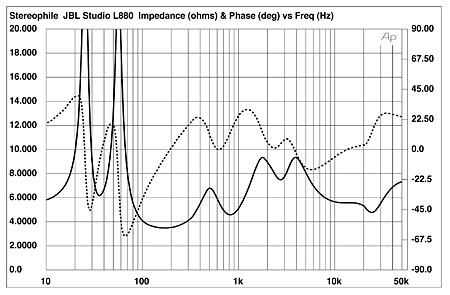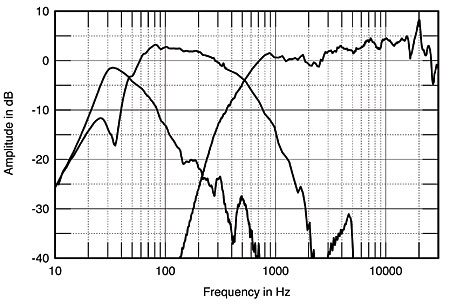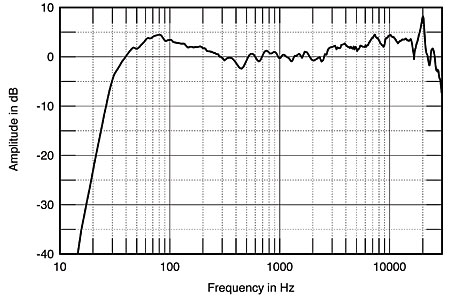| Columns Retired Columns & Blogs |
JBL Studio L880 loudspeaker Measurements
Sidebar 3: Measurements
My estimate of the JBL Studio L880's voltage sensitivity was 90.5dB(B)/2.83V/m, which is within experimental error of the specified 91dB. This places it in the small group of speakers with sensitivities significantly greater than the average. Its impedance, however, drops to 3.82 ohms at 170Hz (fig.1), which, in combination with a moderately high electrical phase angle of –51° at 84Hz, where the magnitude is a still-quite-low 5.1 ohms, means that an amplifier or receiver rated at 4 ohms will work best with this speaker.

Fig.1 JBL Studio L880, electrical impedance (solid) and phase (dashed). (2 ohms/vertical div.)
The traces in the impedance graph are free from the small discontinuities that would indicate the presence of cabinet vibrational resonances. When I was moving the speaker around, however, I couldn't help noticing that the large, unbraced cabinet was very lively, and an accelerometer fastened to the various cabinet surfaces revealed some major high-Q resonances. Fig.2, for example, a waterfall plot calculated from the accelerator's output when fastened to the center of the sidewall 12" from the top, reveals a very-high-level mode at 285Hz, and two others almost as strong, at 320Hz and 350Hz. I could hear these modes adding a hollow coloration on pink noise; I must assume they contributed to Bob Reina's criticisms of the speaker's emphasis in the lower midrange.

Fig.2 JBL Studio L880, cumulative spectral-decay plot calculated from the output of an accelerometer fastened to the cabinet's side panel level with the midrange unit (MLS driving voltage to speaker, 7.55V; measurement bandwidth, 2kHz).
Turning to the L880's acoustic performance, fig.3 is a composite showing the farfield responses of the tweeter-midrange and woofer sections, taken without the grille, spliced to the nearfield response of the midrange unit, of the port, and the sum of the nearfield woofer outputs. The impedance graph indicated that the big, front-panel–mounted port is tuned to a low 35Hz, with a broad peak between 25Hz and 50Hz in fig.3 defining its output. The port response is also commendably free from high-frequency spuriae. The minimum-motion point of the summed woofer outputs in this graph lies at 35Hz, the port tuning frequency, but the individual outputs of the woofers (not shown) lie slightly to the sides of this frequency. The woofers cross over to the midrange unit just above 500Hz, with symmetrical, ultimately fourth-order rolloff slopes. Though one treble peak can be seen in the woofers' output, this is a long way down in level.

Fig.3 JBL Studio L880, acoustic crossover on supertweeter axis at 50", corrected for microphone response, with the nearfield responses of the port, woofers, and midrange unit plotted below 700Hz, 350Hz, and 500Hz, respectively.
The midrange unit's response is flat in its passband, but the output of the two tweeters looks shelved-up by a couple of dB in fig.3, which was taken on the supertweeter axis. This can also be seen in fig.4, which shows the L880's farfield response averaged across a 30° horizontal window on the supertweeter axis, spliced at 300Hz to the complex sum of the nearfield responses. The response, however, is flat through the midrange and treble, and the apparent rise in the mid- and upper bass is actually due to the nearfield measurement technique. In actuality, the JBL L880 is maximally flat down to 40Hz or so, with then the expected 24dB/octave rolloff below the port tuning frequency—a textbook reflex alignment. In-room, the usual low-frequency room gain will give a response that is flat down to 32Hz or so, as Bob found in his auditioning.

Fig.4 JBL Studio L880, anechoic response on supertweeter axis at 50", averaged across 30° horizontal window and corrected for microphone response, with the complex sum of the nearfield responses plotted below 300Hz.
The L880's treble will never be heard as reticent, but Bob Reina was not bothered by an excess of top-octave information. The reason, I believe, is that the JBL's lateral dispersion is quite narrow in this region (fig.5), which will work in-room against the on-axis excess. Below 7kHz, the speaker's horizontal radiation pattern can be seen to be wide and even. In the vertical plane (fig.6), the L880 maintains the evenness of its output for 10° above and below the 37.5"-high supertweeter axis. Only when the listener's ears are well below that axis does a suckout begin to develop in the crossover region between the midrange unit and tweeter.

Fig.5 JBL Studio L880, lateral response family at 50", normalized to response on supertweeter axis, from back to front: differences in response 90–5° off axis, reference response, differences in response 5–90° off axis.

Fig.6 JBL Studio L880, vertical response family at 50", normalized to response on supertweeter axis, from back to front: differences in response 15–5° above axis, reference response, differences in response 5–15° below axis.
In the time domain, the JBL's step response (fig.7) is complex. However, inspection of the individual drive-unit steps (not shown) indicates that all five units are connected with positive acoustic polarity and that, the supertweeter aside, the output of each smoothly integrates in time with that of the next lower in frequency, correlating with the excellent frequency-domain integration noted in fig.4. The supertweeter's horn loading means that it is set back slightly, delaying its output. I suspect that its step response is the small peak rising above the midrange unit's step just past the 4ms mark in this graph. Finally, the L880's cumulative spectral-decay plot (fig.8) is superbly clean throughout the upper midrange and treble.

Fig.7 JBL Studio L880, step response on supertweeter axis at 50" (5ms time window, 30kHz bandwidth).

Fig.8 JBL Studio L880, cumulative spectral-decay plot at 50" (0.15ms risetime).
Like the similarly priced Revel F12, which Kal Rubinson reviewed in July, JBL's Studio L880 is evidence of some sophisticated loudspeaker engineering being performed at Harman International, the parent company of both brands, as well as Infinity.—John Atkinson
- Log in or register to post comments




































